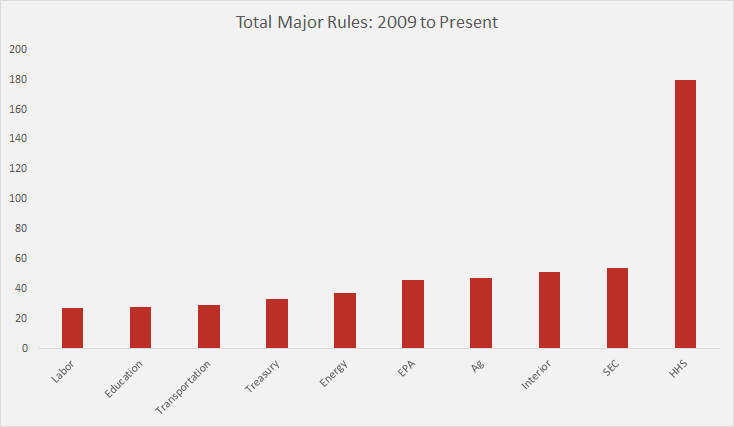Insight
May 23, 2017
On the Cumulative Impact of Regulation: HHS Leads the Way
As federal agencies comb through their existing regulations to comply with the one-in, two-out executive order on regulatory reform, regulators at the Department of Health and Human Services (HHS) will have plenty of major rules to review. According to American Action Forum (AAF) research, since 2009 HHS has paced the pack of federal agencies, issuing 180 major regulations (rules with an economic impact of $100 million or more). Given the implementation of the Affordable Care Act since 2010, this shouldn’t be too shocking. However, it might surprise many to learn that the Environmental Protection Agency (EPA) is fifth, not first or second, and the Securities and Exchange Commission (SEC) is, by major regulation, the second most prolific regulator. SEC has issued 54 major rules since 2009, which is notable, but still less than a third of HHS’s total.
The graph below charts major regulation by agency since 2009.
As the numbers make clear, there has been plenty of regulatory activity at HHS. As a result, regulators seeking to examine past rules to revise or repeal will have plenty of options to review within HHS. It is surprising that an independent agency, SEC, leads all other agencies, save HHS. This is likely due to its implementation of Dodd-Frank, which has generated 65 major rules. SEC is responsible for 23 of these major rules, or 35 percent. Given its relatively narrow scope, compared to EPA or the Departments of Labor and Treasury, it is somewhat startling that SEC has issued eight more rules than EPA and 21 more than the Treasury.
In terms of the largest HHS rules that regulators could examine, here are the recent regulations with the highest annual costs:
- Medicaid, CHIP, and Exchanges: $1.3 billion
- Health Insurance Portability: $1.1 billion
- Medicaid Community First Choice: $1.1 billion
- Reform of Requirements for Long-Term Care: $758 million
- Adoption of Operating Rules: $745 million
- Exchanges and Qualified Health Plans: $690 million
Combined, HHS has promulgated more than $73 billion in total burdens, but far less than the Department of Energy and EPA. On the paperwork side, it has imposed at least 142 million new hours, largely as a result of the ACA. Consider, in 2007 HHS imposed 453 million hours of paperwork; today that figure stands at 1.3 billion, triple the paperwork in just ten years.
These recordkeeping and reporting requirements could prove to be low-hanging fruit as HHS examines its regulatory slate. For instance, its “Hospital and Critical Access” reform of 2012 reduced 5.1 million hours and saved nearly $1 billion annually. In addition, its home health safety provisions reduced 192,000 hours in 2014 and saved $21 million annually. Replicating these savings is essential to implementing the one-in, two-out order on regulatory reform.
Broadly, comprehensive reform, perhaps embodied in the American Health Care Act (AHCA), would do a great deal to eliminate costly regulatory requirements. Beyond the targeted ad hoc approach of revising and repealing specific old rules, fundamental reform could generate the same savings that the ACA generated in costs. Repealing the entirety of the ACA won’t make the sunk costs from the past seven years disappear, but there is little doubt it could produce billions of dollars in cost savings.
Options for SEC
Under the executive order on reform, SEC is clearly exempt from the requirements. They don’t submit their regulations to the executive branch and under current law, they cannot be compelled to comply with the one-in, two-out order. However, the Federal Communications Commission (FCC) has voluntarily agreed to reduce its regulatory burden. Undoing burdensome command-and-control Internet rules is a first step. SEC could choose to review its existing regulatory slate and revise it to lower costs for individuals and businesses. For instance, it technically already has $1.3 billion savings from the congressional repeal of the “Resource Extraction” rule, required by Dodd-Frank.
If SEC decided a more comprehensive review were warranted, here are the top five rules (by annual cost) that remain on the books:
- Amendments to Regulation SHO: $1.1 billion
- Pay Ratio Disclosure: $526 million
- Investment Company Swing Pricing: $286 million
- Dissemination of Security-Based Swap Information: $275 million
- Standards for Security-Based Swap Dealers: $226 million
Two other Dodd-Frank rules should have also made the list, but the courts and the Congressional Review Act have at least temporarily rescinded those regulations. Whether SEC decides to act on these rules listed here, or older rulemakings, is for the discretion of the Chairman Jay Clayton.
Conclusion
Much of the hunt for duplicative or onerous past rules will require a thorough program evaluation. It’s likely the older the rule, the more it has generated in sunk costs, limiting the economic gains of repeal. However, with 180 major rules from HHS and 54 from SEC, there are plenty of options as regulators scour their regulatory slate for potential cost savings.











